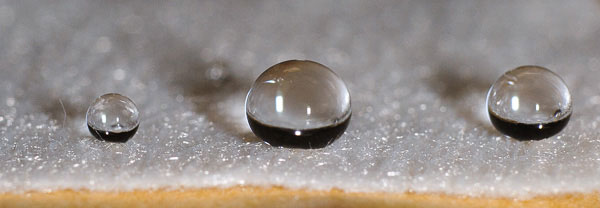IND56 Q-AIMDS Chemical metrology tools for manufacture of advanced biomaterials in the medical device industry
The global medical device industry is estimated at over €200 billion annually and European manufacturers currently hold 35% of the market. Although implantable medical devices improve quality of life for millions of people, the rates of complications and failures due to incompatibility of the devices with human tissues and device related infections are unacceptably high. A number of promising strategies are being implemented to reduce these complications and failures including thin film coatings, surface grafted biomolecules, nano-particle coatings, and drug eluting materials.

Droplets on hydrophobic dressing
Manufacture and certification of devices that employ these advanced biomaterials will require traceable, reliable metrology tools that are able to measure surface layers, surface contaminants, defects and the 3-D distribution of chemical constituents in the near-surface region. The US Food and Drug Administration (FDA) have targeted better quality management of device surface chemistry as an area of growing and concern and new regulations in this area are expected in the near future. We have identified four key needs within the European Medical Device industry:
- Reliable analytical tools capable of detecting thin coatings, grafted organic and biological molecules and contaminants on the surface of medical devices in the manufacturing environment. These analytical techniques must be traceable, reproducible, surface sensitive and chemically specific while at the same time able to operate under ambient conditions, needed in a manufacturing environment, on complex geometries.
- Analytical tools capable of detecting uniformity, thickness and defects in coatings and thin films in the on-line or in-line environment. Methods to detect defects and contaminants at the interface between the coating and the underlying material are of particular interest because they can lead to delamination, cracking and spalling of the coating/films and ultimately lead to device failure.
- Metrology tools that are capable of 3-D chemical state imaging with sub-micrometer spatial resolution for the characterization of coatings, drug eluting materials, and retrieved implants.
- Reproducible, quantitative analytical tools capable of measuring the density and distribution of nano-particles and nano-scale topographic features on device surfaces with varied sizes and geometries.

The research within this EURAMET joint research project receives funding from the European Community's Seventh Framework Programme, ERA-NET Plus, under Grant Agreement No. 217257.
For more information, please contact the project coordinator, fiona.moriarty@npl.co.uk from NPL.